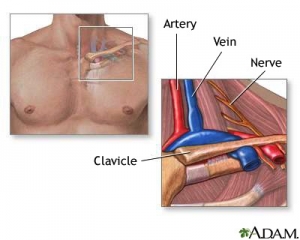Some of the most common conditions that I see in the clinic are neck problems or shoulder and arm issues. These can be separate injuries causing a variety of upper limb signs and symptoms, or they are commonly related.
This month I am focusing on Thoracic Outlet Syndrome. What is this you ask? Thoracic Outlet Syndrome, or TOS, is a condition involving pain in the neck and shoulder, numbness or tingling in the forearm or fingers and possible weakness in the hands.
The thoracic outlet is an area between the ribcage and the collarbone. The scalene muscles, first rib and the clavicle board the outlet. Nerves and blood vessels travel through this outlet on their way to the arms. Sometimes there is not enough space for these to pass though, leading to compression of these nerves and/or blood vessels.
There are several reasons as to why compression occurs. These include:
– An extra rib, known as a Cervical Rib
– Previous injury to the neck or shoulder
– Repetitive use injury involving the neck and shoulder
– People with long necks and low shoulders
– Poor posture with forward head carriage and forward shoulders
Those suffering from TOS usually experience neck pain with diffuse arm symptoms including numbness and tingling. The distribution of the numbness/tingling depends on the nerves affected, but commonly occurs down the inside of the arm into ring and little fingers.
TOS is most commonly seen in people who engage in specific repetitive movements of the shoulder such as full abduction (lifting your arm out to the side) with external rotation. Several sports that involve these movements include, swimming, water polo, tennis, and baseball. Any sports involving throwing and a build up of strength in the dominant arm increases the risk of TOS. These individuals may present with neurological or vascular symptoms. As a chiropractor, a comprehensive patient history should be taken with anyone suspected of having TOS. There is a range of specific orthopedic tests that help us diagnose the condition. Occasionally patients are referred for further imaging such as MRI, nerve conduction test or muscular activation testing. These tests can help differentiate TOS from similar presenting conditions such as; carpal tunnel, shoulder tendinitis or cervical disc injuries.
Generally, management of TOS is conservative with an approach based on postural correction or retaining of functional movement patterns. This includes a mix of joint mobilization and adjustments, physical therapy modalities, home stretching exercises and soft tissue therapy. Patients should avoid prolonged positions that cause them to hold their arms out or overhead. For example, avoid sleeping with the arm extended up behind the head. Weight reduction can be helpful for obese patients. Patients should avoid sleeping on the stomach with arms above the head. They should also avoid repetitively lifting heavy objects.
As TOS is commonly related to repetitive movement patterns, it is essential to address the particular aggravating movements, to prevent the condition reoccurring. This may involve a period of rest from your sport followed by a specific rehabilitation program to retrain the neuromuscular movement patterns.
In the vast majority of TOS cases, a conservative, non-surgical approach to treatment is most effective.
If you would like more information or would like to book an appointment at Neurohealth Chiropractic – please call the clinic on 9905 9099 or email us admin@neurohealthchiro.com.au or fill in the contact form from our website www.neurohealthchiro.com.au
Sign up to receive Neurohealth Chiropractic’s Free monthly health newsletter on the Right Hand Side of this page. Filled with great information and lots of easy health tips to keep you at Optimal Health!




